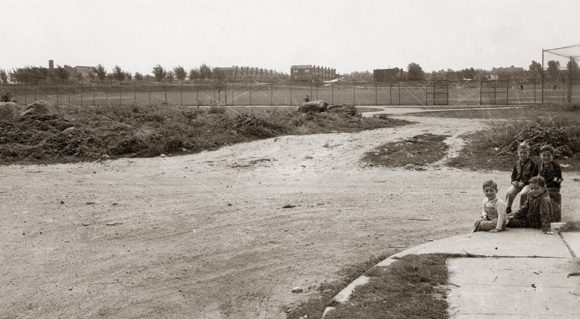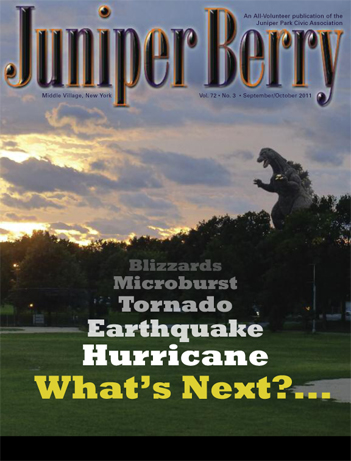In the last issue of the Juniper Berry I detailed the colorful history at the center of our community; Juniper Valley Park. As one can imagine, the park’s more recent history is just as interesting as its past and is spotted with its own set of trials and tribulations. The transition of our park from 1941, its official debut, to the present is quite remarkable and followed a long, sometimes turbulent road.
First, Juniper Valley Park transitioned from a “phantom village” to a Quonset Hut village. The Quonset Huts, located at the west end of the park, housed the families of those who were fighting during World War II. Juniper Park went from being the site of Arnold Rothstein’s fake “residential community” to being the home base for those who were putting their lives on the line to serve our country and protect our lives.
Next, to understand how the park became what it is today we have to go all the way back to 1938; the year the Juniper Park Civic Association was formed. The Association was founded by residents of Middle Village and Elmhurst, and from the beginning existed to serve the community’s best interests.
The JPCA oversaw Juniper’s development and was a steady, concerned voice from start to finish. There were always ongoing debates on deciding what would be incorporated in the park. The JPCA usually fought opposition from individuals and groups who were not Middle Village residents and did not understand the detriment of building an over-the-top park in a small, residential neighborhood. Finally, in 1941, Juniper Valley Park made its public debut with facilities that were suitable and beneficial for the entire community.
The park originated initially with facilities located east of 76th Street. The agreed upon features of the park included four baseball fields, eight tennis courts, a handball court and sprinklers and a wading pool. It wasn’t until 1967 that west of 76th Street was developed, and that added more baseball fields, a soccer and football field and a running track to complete the park. The year of 1967 also brought parking lots to the north and south ends of the park that would eventually lead to scandal. Another issue that plagued the park in the 1960s was whether or not to build a public swimming pool in Juniper.
The JPCA was one hundred percent against the proposed idea. A public swimming pool in one of the most popular parks in Queens that just happens to be nestled inside an incredibly cozy, residential neighborhood? Bad idea. Of course the idea was championed by those who didn’t live in the area. They couldn’t understand the fact that building a public swimming pool in a neighborhood with limited transportation and security resources was a bad idea that would only cause more harm than good. The JPCA fought hard to keep the pool from being built and came out victorious.
Although the JPCA won the pool struggle of the 1960s, more trouble was on the horizon. The 1970s was a tough time for the City of New York as it faced financial hardships under the leadership of Mayor Abe Beame. The city was almost forced to declare bankruptcy. The financial disarray resulted in NYC public parks with a lack of funds, which led to Juniper turning into a neglected mess.
The beautiful, lush park we know and love today was a hot bed for debauchery, drugs and other illegal activities. There was little police enforcement at the time because of the funding shortages. A place where residents were once able to relax and enjoy a day outside or a friendly game of ball, Juniper was not so welcoming anymore. If one were to stroll through the park during the 1970s he or she would find benches torn out of the ground, the fields in deplorable conditions and the park house burned down.
The parking lots that were added to the park in 1967 were overtaken by drug dealers, prostitutes and all night parties, and, with sparse funding for adequate police patrol, were by far one of the biggest problems facing the park. Lorraine Sciulli, of the JPCA, was instrumental in finally getting those lots closed with the help of then Councilman Arthur Katzman and the JPCA. She was able to draft a petition and acquire hundreds of signatures to shut the parking lots down for good and rid our neighborhood of that negative element. The closing was accomplished within a year; a record achievement at the time, and the uphill battle to take the park back was well on its way. The former north and south parking lots of Juniper Valley Park are now beautiful green areas with stately trees that welcome passive recreation.
Once Ed Koch came into office as the Mayor of New York City in the mid-1970s, and with the help of NYS Governor Hugh Carey, the city was rescued from bankruptcy and received funds for its survival. Juniper Valley Park was finally in an upswing with careful oversight and maintenance. The park really came into its glory days between 1991 and 2001; the years Councilman Tom Ognibene was in office.
Tom Ognibene worked closely with JPCA President, Bob Holden, in rehabilitating our park. Juniper had a major facelift during that time period including the new upper baseball fields, a roller-hockey rink, a new running track and football fields. The addition of the roller-hockey rink did stir up its own pot of controversy with opposition facing its creation because of the residential surrounding of the park and the noise that a hockey rink would create. It was, however, eventually solved and added to the park when Bob Holden drew up a plan for the rink and upper baseball fields in a section that was tucked in away from the residential areas of the neighborhood.
Since 2001, Juniper has continued to experience even more renovations with new, state-of-the-art children’s playgrounds.
We cannot write a history of Juniper Valley Park without mentioning the fact that to this day there remains territorial tension between sports and passive recreation. There’s a prevailing thought that parks are built only for the children and for playing sports. That’s not true because all city residents pay the taxes for our parks.
Sites within a park, Juniper included, are set aside for passive recreation where one can come in the park and if they want, sit on a park bench all day and read a book without worrying about getting hit with a sporting event activity.
Trees are welcome and need to be nurtured and recently many new trees were planted. Some sports leagues have trouble with the concept of sharing sites for passive recreation, but with careful oversight from the JPCA they are kept under control.
There is no question that the 55-acre oasis we have as the anchor of our community today took a taxing, at times rough journey to get where it is today. The Juniper Park Civic Association played an integral role in developing and maintaining the park in its current state-of-the-art condition, and will continue to propel the park to a great future serving our community. Without the oversight of the JPCA championing for our park and being a voice for neighborhood, Juniper Valley Park would not be the beautiful place we know and love today.




